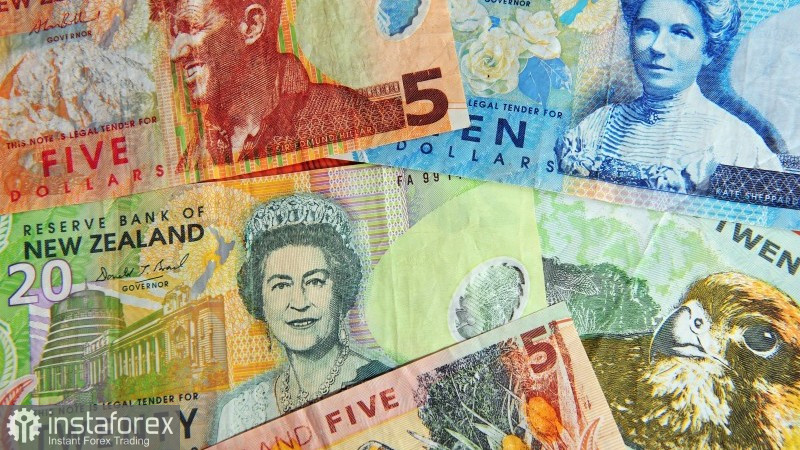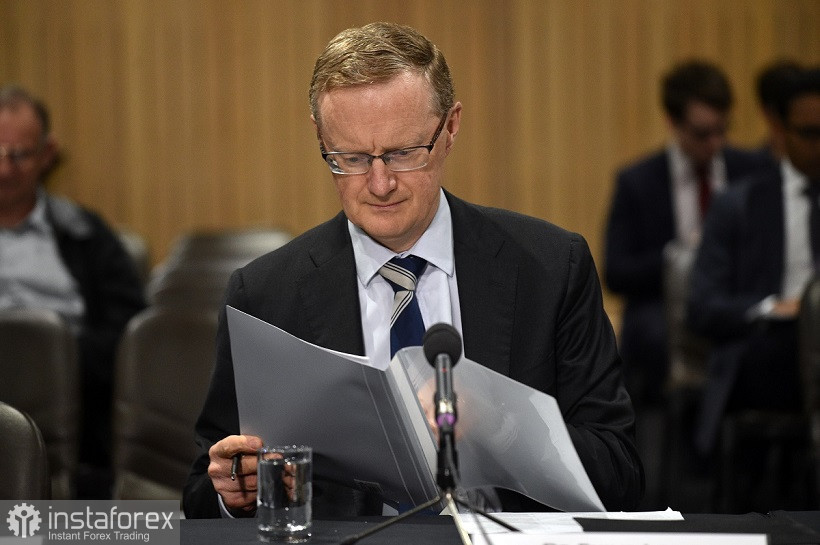New Zealand published its key labor market data during Wednesday's Asian session. The release turned out to be controversial, so market participants reacted differently to it. For example, NZD/USD traders showed a positive reaction, although the pair's growth was limited. Meanwhile, the AUD/NZD cross-pair increased: the New Zealand dollar was under pressure after the publication, and the Australian dollar received some support from the RBA Governor, Philip Lowe, who unexpectedly admitted the probability of an interest rate increase within this year. As a result, the cross-pair rose to the resistance level of 1.0750 (upper line of the Bollinger Bands indicator on the daily chart).
In general, the RBA head really shocked us today. The Australian dollar was under significant pressure (including in pair with the New Zealand dollar) yesterday, reacting to the results of the February meeting. On the one hand, the regulator announced the early termination of the stimulus program, which was originally supposed to end in May. In addition, RBA members noted a significant increase in inflation indicators and a decrease in unemployment in the country. On the other hand, the Central Bank put hold on the issue of increasing the interest rate. In an accompanying statement, the Central Bank indicated that the early curtailment of the stimulus program does not hint an imminent interest rate hike.

Such signals put pressure on the Australian dollar, including paired with the New Zealand dollar. The AUD/NZD cross-pair fell almost 100 points yesterday but has more than recovered all the losses today. The strengthening of the upward movement is not only due to Philip Lowe's rhetoric but also to the New Zealand data.
As mentioned above, New Zealand published its key data in the labor market during the Asian session on Wednesday. The positive side of the release is the decline in the unemployment rate, which fell in the fourth quarter of last year to the level of 3.2% (the forecast was at the level of 3.3%). It is worth noting that unemployment has been declining for five consecutive quarters, after peaking at 5.3% in the third quarter of 2020.
All other components of today's release were in the "red zone". First, the growth in the number of employed has slowed down significantly. This indicator grew by only 0.1% in quarterly terms In the 4th quarter of last year, compared to 1.9% in the third quarter. Experts actually predicted its decline to 0.4%, but the result was even weaker. In annual terms, negative dynamics were also recorded – the indicator slowed down to 3.7% after rising to 4.2% in the 3rd quarter. The share of the economically active population also decreased (71.1%). On the one hand, we are talking about a minimal decline, but the fact itself is important since this indicator has shown a positive trend for five consecutive quarters. Salaries also left an ambiguous impression.
It shows that the above figures can be interpreted in different ways. In the context of the AUD/NZD pair, traders have made a choice not to favor the New Zealand dollar. Moreover, the head of the RBA exerts more pressure, who admitted today the possibility of an interest rate increase this year. Philip Lowe said that such a scenario is not excluded (previously he categorically ruled it out), but to do this, the labor market must reach the level of full employment, and inflation must demonstrate further growth.
According to the RBA forecasts, the unemployment rate will decline to 3.7% by the end of this year from the current value of 4.2% and will remain at this level next year. Wage growth is also expected to rise to 2.75% this year and reach the 3% mark in 2023. Philip Lowe made it clear that the regulator is "ready to be patient," but if the labor market and inflation show more significant growth (relative to the forecasts of the RBA), then the Central Bank will consider the scenario of a rate increase. 
Actually, the Governor of the Reserve Bank of Australia did not announce the tightening of monetary policy – he only allowed such a scenario to develop. In this case, the "surprise effect" played in favor of the Australian dollar, since just yesterday, the Central Bank stated that "the end of the bond purchase program does not mean an early increase in the interest rate." Philip Lowe also ruled out the possibility of tightening monetary policy in 2022 in his previous speeches.
In my opinion, the "hawkish" remarks of the RBA Governor will not become a driver for the growth of the AUD/NZD cross-pair. First, Lowe spoke of too distant prospects. Second, he voiced rather high demands, the fulfillment of which will open the way to a rate increase. It should also be noted that despite the impulse growth, the pair could not break through the resistance level of 1.0750 (the upper line of the Bollinger Bands indicator on the D1 timeframe) today. Therefore, we can consider the option of short positions with the first target of 1.0690 (the Tenkan-sen line on the same timeframe) and the main target of 1.0650 (the average line of the Bollinger Bands indicator on D1) within the framework of medium-term trading.
 English
English 
 Русский
Русский Bahasa Indonesia
Bahasa Indonesia Bahasa Malay
Bahasa Malay ไทย
ไทย Español
Español Deutsch
Deutsch Български
Български Français
Français Tiếng Việt
Tiếng Việt 中文
中文 বাংলা
বাংলা हिन्दी
हिन्दी Čeština
Čeština Українська
Українська Română
Română

